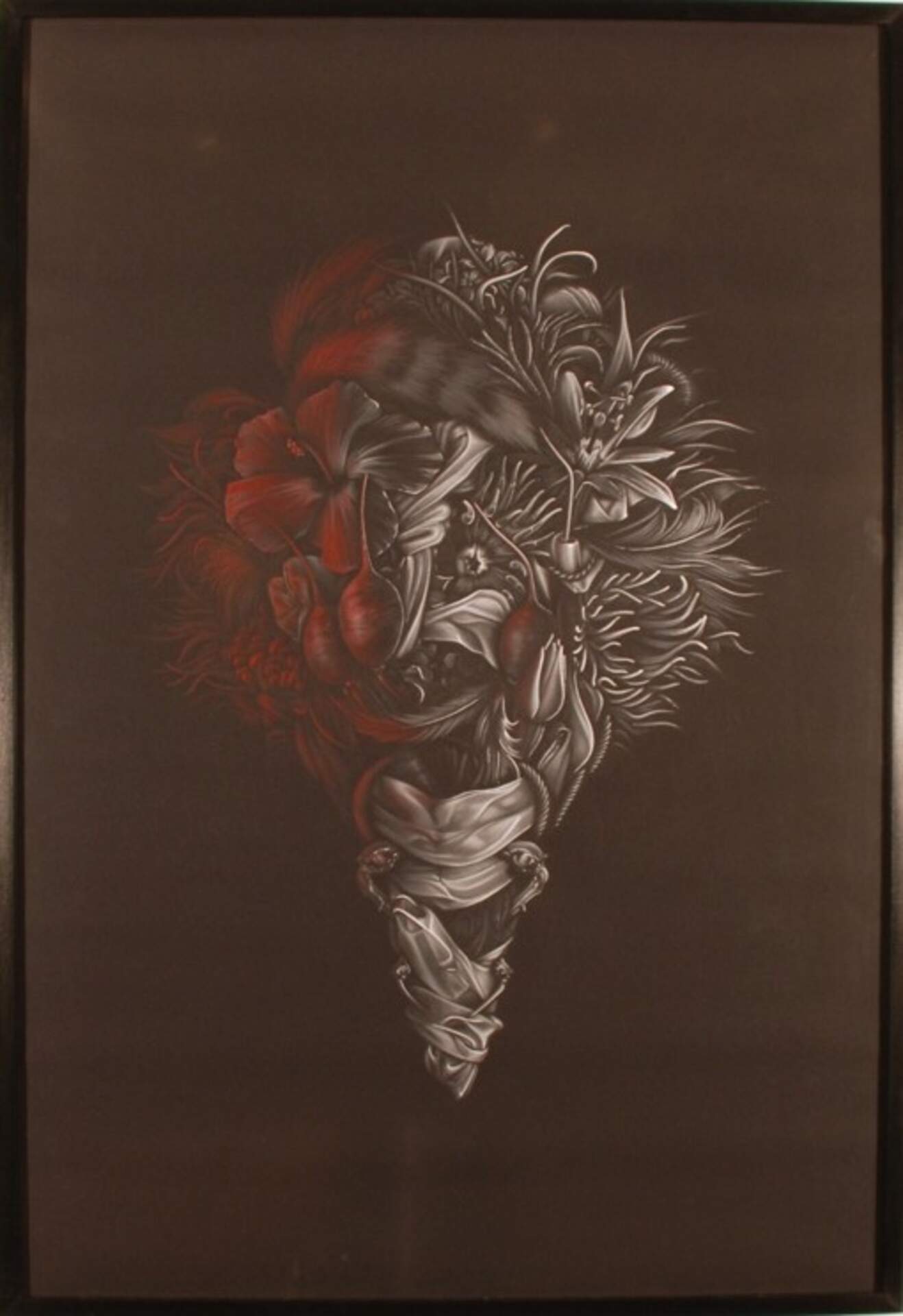Megan Greene b. 1976Billie
2008
colored pencil, gouache on black paper
44 x 30 inches
Burchfield Penney Art Center, Gift of James E. & Suzanne G. Hofmeister, 2008
The artist provided this statement about her work:
The source material I use for these white-on-black drawings is varied, from tiaras to meatballs to teeth. The best way for me to speak about the themes of decadence, mutation and belief in my work is to sort through this junk drawer of parts.
Jewelry, ruffles, hair, ribbons, lace, etc. speak to my interest in ornamentation. Layers of coiffed costume give a kind of arch, pageantic femininity to my work, Baroque in its excess and Victorian in its sublimated control. With it comes a figurative aspect; is this invented structure something to be worn—a headdress, mask or hairdo—and how? Related is my interest in tribal adornment, particularly of Pacific Islander culture, including ceremonial pieces made from animal teeth and hair. Add to it my attraction to English mourning jewelry (differently made of hair) and vanitas painting, and what emerges is a kind of complicated beauty—by turns elegant, bestial and dark.
Armor, medals—military and otherwise—epaulets, festoons, amulets, etc. all concern themes in my work of ritual and systems of belief. (See Pig Ear One and Los Norkuyles). Such objects are intrinsically earnest and reverential. This solemn, honorific quality interests me, as does the question of what happens when such totems are mixed together and in excess, their potencies heightened or leeched and made idolatrous. My intention in these drawings (some more than others) is to create an aura of belief and ceremony that feels both specific and culturally unclear. Meanwhile, this charge of spiritual purpose relates to my use of machine parts (see The Sorriest Sword). In the spirit of Picabia’s absurd machines, I refer to mechanical function in my work, suggesting a believable but unknown use.
Feet, fur, hooves, horns, ears, tentacles, antennae and parts taken from jellyfish and similarly membranous creatures, as well as cuts of plants and flowers, lend a biological specimen-like quality to my work. With these elements, I attempt to make structures that appear carnal and animate, like that of a hermaphroditic or asexual species—prehistoric, futuristic, mythical, or newly discovered. My approach is like that of a naturalist, de-clawing and embellishing.
Last are some of my many reasons for working white on black. To my mind, working on an intrinsically black surface is a way of upending some of the demands and baggage of the picture plane and of mark making, in that black has a readymade presence and fullness, without the same expectation of a white expanse. Further, I am compelled by qualities innate to a black surface: that it is theatrical and presentational (as in the “black box” or a piece of velvet upon which a brooch is laid or a butterfly pinned), that it renders the structures upon it ghostly and luminescent, that it feels solitary, silent and indeterminate—like deep space, deep sea or somewhere in between. — Megan Greene
This drawing was shown in the artist’s solo exhibition at Hallwalls, Megan Greene: Rappacini’s Daughter, held January 12 through February 16, 2008. The overall composition resembles the composite portrait heads painted by Giuseppe Arcimboldo (1527-1593) that incorporated elements, such as fruit, vegetables, and flowers, which were combined to suggest qualities associated with the actual or mythological subject. Although the artist said it was not her explicit intention, she thought the suggestion that the subject suggested in the title may be the famous jazz singer Billie Holiday (1915-1959) was valid. Carefully rendered objects associated with feminine beauty and sexuality (satin ribbon, fur, feathers, hibiscus, tulips, sea urchins, etc.) are tied together in a surreal bouquet with three red beets and a pointed object that provide an ominous quality. The composition subtly transforms from red to white in a limited color palette on black paper. This amplified effect suggests not only Holiday’s history as one of the first African American women to be respected for her artistry, but the colors suggest death touching upon life, as resonated within the hidden theme of lynching in the song, “Strange Fruit,” which Holiday introduced in 1939.
A general description of Greene’s recent series appeared on Hallwall’s Web site; it was provided by the Kinz, Tillou + Feigen Gallery which presented a solo exhibition of her work in New York at their space at 529 West 20th Street:
Megan Greene’s detailed white on black drawings combine the forms of flora, feathers, hair and jewelry in manners Baroque and tribal. The careful topiary-like displays of such feminine ornaments both heighten and belie their frivolity, appearance of purpose and fetishistic quality. Greene’s work shows her interest in mammals, birds, deep-sea creatures and insects to an effect reminiscent of Victorian naturalist drawings. These organic elements become ghostly, hermaphroditic and ornamental.
In each drawing, the strange composite of such components suggests themes transcendent of each literal part: of elegance and delicacy mixed with the macabre, of body parts and biological specimen through the incarnation of the prehistoric and futuristic, and of cultural artifact, be it headdress or totem. The subject of these drawings lies in the intentionally ambiguous interplay of these various qualities.
(Entry by Nancy Weekly)
